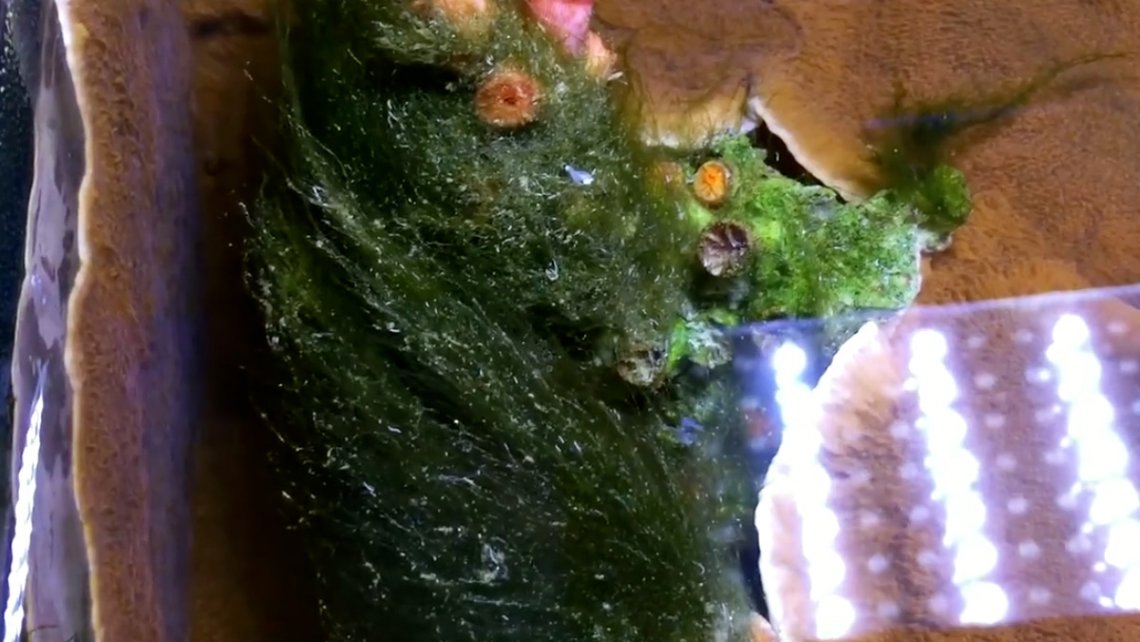Getting Rid of Green Hair Algae
Green Hair Algae (abbreviated as GHA for this article) - Derbesia - is a form of algae that looks like its name. It is usually dark green, grows quite long if left unattended and spreads across your tank rapidly. Once this problem has begun, it can get out of hand in a matter of weeks. And soon you start to look at your tank in disgust, thinking “Why me? What did I do to deserve this plague?”
A number of things may have contributed to it getting a foothold in your system. Your nitrates might be too high, your phosphates may be too high (.03 or less is the goal), your lighting has recently been replaced or perhaps your bulbs are so old that the spectrum of light has shifted, fueling algae growth.
First things first. You need to get your water parameters to Natural Sea Water levels:
|
pH: 8.0 to 8.3 |
Alkalinity: 8 to 11 dKH |
|
Ammonia: 0ppm |
Salinity: 1.026sg |
|
Nitrites: 0ppm |
Calcium: 375 to 425ppm |
|
Nitrates: 0 to 10ppm |
Phosphate: 0.03ppm |
A lot of these are affected by the water quality you use before you even begin to mix your saltwater. If you use tap water, you might be adding nitrates or phosphates to your tank on a daily or weekly basis. RO/DI water is your best and most pure option. If your phosphates are high, you can use a product like Phosphate Rx (my preference) to bring them down to recommended levels.
Okay, so your water is great. To get rid of the algae, you are going to have to prune it back manually. Fortunately, you can get some help from ocean dwellers, but like anything, when you have too much of something, you have to get radical to bring it within manageable levels. Nothing good ever happens quickly, right? This is going to take some specific attention on your part for a few weeks, but you can overcome it.
Get a container of fresh water (tap is fine) and put it near your tank. I like to have it on the top edge of the tank. If you can clip it to keep it in place, even better. Reach into your tank, and pinch off a clump of the stuff. Pull your hand out still pinching the GHA so none of it gets released into your tank, and dip/rinse your fingers off in the water. Repeat this a hundred times. ![]()
The reason you rinse your hand after each pinch is to prevent the filaments from floating around in your tank and reattaching elsewhere, just spreading your problem further!
When your hand gets tired, switch to the other hand. Take your container and dump it out, rinse it well and put more water in it and get back to work. Try to remove as much as you can see and reach, working at this daily. By ripping it out in bulk, you prevent it from spreading, and you give your hermit crabs and snails something they can actually keep up with. Buy more snails to help with the battle. I prefer Turbo snails.
Whenever you see a snail that is not working on the GHA, pull it off the glass/powerhead/plumbing and put it on an area of algae. They work for you.
Clean your skimmer completely. Clean the pump/powerhead thoroughly, make sure your air intake is clear. Clean your collection cup often, so you don’t have slime buildup hindering it. You want to skim out as much of the Dissolved Organic Compounds (DOCs) before they can break down in your tank and add to the A-N-N cycle. Remember nitrates fuel algae growth. You want 10ppm or less to avoid feeding GHA. If your skimmer is underpowered for your tank, seriously consider upgrading to a better unit.
If you’ll keep up with this process for a few weeks, you’ll see less and less in your tank, until one day, your tank is pristine again. If you come to visit, you’ll see my little reef is cured, but it did take time and effort. There are other things you can try, such as putting your live rock in a covered dark container for a month, trying fish (foxface, lawnmower blenny, yellow tang), or invertebrates (diadema urchin), but this system works well and allows you to beat GHA. After all, it is merely algae, right?












